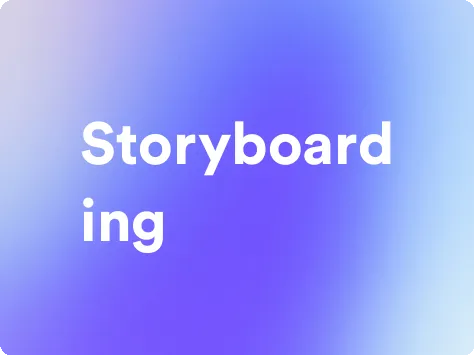Storyboarding: Enhancing Productivity and Planning
This guide will walk you through the essential elements of using storyboarding - the productivity method to keep your team productive and engaged.
Try Lark for Free
In today's fast-paced and visually-driven world, the art of storyboarding holds immense importance across multiple sectors. Its versatility, coherent visualization, and strategic planning contribute significantly to the success of projects, making it a vital skill to master. This article will provide an in-depth exploration of storyboarding, including its history, applications, benefits, and practical tips for effective implementation.
What is Storyboarding?
Storyboarding, in the context of productivity, refers to the technique of visually organizing and planning a project's elements in a sequence. It involves creating a series of illustrations or images that represent each essential component of the project, such as scenes, frames, or steps. This visual representation aids in effectively conveying the project's narrative, ensuring clarity and alignment among the team members. Notably, storyboarding serves as a powerful tool for refining ideas, enhancing communication, and streamlining the project management process.
Use Lark to unleash your team productivity.
The Origin of Storyboarding
The concept of storyboarding traces its roots back to the early 20th century, primarily emerging within the animation industry. Walt Disney Studios is credited with popularizing the use of storyboards in the 1930s, aiming to pre-visualize animated films and streamline the production process. Over time, the technique gained widespread recognition and has since evolved to become a fundamental aspect of not only animation but also film-making, advertising, and other visual storytelling domains.
Who Uses Storyboarding?
Professionals across a myriad of industries benefit from incorporating storyboarding into their practices. From film directors and animators to UX designers, marketers, and project managers, the technique finds relevance in enhancing visualization, communication, and organization. Storyboarding serves as a versatile tool that aids in aligning team members' perspectives, fostering creativity, and effectively conveying concepts, making it an indispensable asset for individuals and teams seeking to bring their ideas to life.
Learn more about Lark x Productivity
Pros and Cons of Storyboarding
Pros:
- Enhanced Clarity: Visual representation aids in conveying complex concepts effectively.
- Effective Communication: Facilitates seamless understanding and alignment among team members.
- Strategic Planning: Enables thorough pre-visualization, leading to efficient project execution.
- Refined Creativity: Inspires innovation and creative input, enhancing the quality of the final output.
Cons:
- Time-Intensive: Creating detailed storyboards can be a time-consuming process, potentially impacting project timelines.
- Rigid Structure: Excessive detail in storyboards may limit flexibility in the project's creative direction.
- Initial Learning Curve: Adeptly utilizing storyboarding techniques requires a foundational understanding of visual storytelling and planning principles.
Use Lark to unleash your team productivity.
Getting Started with Storyboarding
Embarking on the journey of storyboarding necessitates a firm grasp of its foundational elements and available resources. Here's a comprehensive guide to initiating the storyboarding process:
Understanding the Story
At the core of successful storyboarding lies a clear comprehension of the narrative or message that the project aims to convey. It entails identifying the central themes, pivotal scenes, character interactions, and any other essential story components.
Sketching the Frames
Commencing with rough sketches or frames that visually represent each significant element of the narrative. These visual representations should align with the overarching storyline and effectively convey the intended message.
Adding Details
Incorporating annotations, descriptions, and additional context to the frames to provide a comprehensive understanding of each storyboarded element. These details serve to enhance clarity and contextual relevance.
Review and Refinement
Seeking feedback from team members and stakeholders and making necessary adjustments to the storyboard based on the received input. This iterative approach ensures the refinement and alignment of the storyboard with the project's objectives.
Examples of Storyboarding
-
Film-making: Directors utilize storyboards to meticulously plan and visualize each scene, determining camera angles, character movements, and overall pacing.
-
Product Development: Storyboarding proves invaluable in illustrating user experiences, displaying product functionalities, and mapping out the user journey, ultimately guiding the development process.
-
Marketing Campaigns: Marketers and advertisers leverage storyboards to craft compelling visual narratives that drive impactful communication and resonate with the target audience.
These scenarios exemplify the versatility and practical application of storyboarding across diverse industries, reinforcing its status as a multifaceted and potent planning tool.
Actionable Tips for Storyboarding in Productivity
- Concise Visuals: Ensure that the visuals used in storyboarding are clear and concise, effectively conveying the intended message.
- Feedback Integration: Actively incorporate feedback and revisions into the storyboarding process to enhance its quality and alignment with project goals.
- Narrative Flow: Maintain a cohesive narrative flow throughout the storyboard, fostering seamless understanding and connection among the depicted elements.
- Collaborative Approach: Encourage active collaboration and input from team members, leveraging diverse perspectives to enrich the storyboard's impact and effectiveness.
Do's and Dont's
| Do's | Don'ts |
|---|---|
| Utilize clear and concise visuals | Avoid overcomplicating the storyboard |
| Integrate feedback and revisions | Don't rush through the storyboarding process |
| Ensure alignment with project objectives | Avoid including unnecessary details in the frames |
| Foster collaboration with team members | Don't disregard the importance of narrative flow |
Adhering to these do's and don'ts is crucial in ensuring the creation of effective, impactful storyboards that facilitate seamless project planning and communication.
Use Lark to unleash your team productivity.
Conclusion
In conclusion, storyboarding serves as a linchpin in the success of varied projects across sectors, enabling the visualization, planning, and communication of ideas and narratives. Its roots in animation have branched out to permeate numerous industries, offering a dynamic means of aligning team members, refining creativity, and streamlining the project management process. As technology and visual storytelling techniques continue to evolve, the pertinence of storyboarding remains unwavering, posing as an indispensable skill for professionals seeking to enhance their productivity and planning methodologies.
